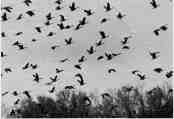 |
Home | Search | Browse | About IPO | Staff | Links |
 |
Home | Search | Browse | About IPO | Staff | Links |
|

A flock of Canadian geese settle down at Horseshoe Lake Refuge as evening approaches. It is estimated that 3,000,000 Canadian geese migrate each year to southern points along the nation's four general flyways.
Southern Illinois Goose Drive-throughs and roadside observation stands allow motorists to see thousands of geese as close as 200 yards away. Hunting meanwhile has become one of the area's most important source of income. By Jeff Smyth Most of the geese that fill the October skies of Illinois and surrounding states in the familiar "V" formation are part of the Mississippi Valley Population (MVP)-a flock that breeds in the Hudson Bay lowlands of northern Ontario and migrates each fall to pre-determined areas in Illinois, Wisconsin, Indiana, Michigan, Kentucky and sometimes as far south as the Mississippi River delta. Illinois' 58,000 acres of government operated refuges, covering parts of Jackson, Union, Alexander and Williamson Counties, attract the largest contingent of these winter guests. Hunters and visitors to the area spend millions of dollars each year. This significant source of income, coupled with the delicate maintenance required for the population's survival, has state and federal officials keeping close tabs on the geese. The vast congregation of Canada geese in southern Illinois (which peaked at over 500,000 in 1977) represents an evolution caused both by nature and man. "When we think of the Canada goose in its migration south, we associate it with the Mississippi River, its bayous and flood plains. That is where they naturally spend their winters, " said W. D. Klimstra, director of the Cooperative Wildlife Research Laboratory at Southern Illinois University at Carbondale. "But with dramatic man-made changes in the river causing a depletion of bottom lands, we needed to compensate with development of resource and conservation areas."
(This article is excerpted from one of a series of features about places, people and attractions in Illinois provided by the Office of Tourism. The author is a staff employee of the Office.) In 1927 the state-managed 3,500-acre Horseshoe Lake Refuge in Alexander County was established. Named after an ancient oxbow of the Mississippi River and dammed to retain water year-round, the refuge attracted 30,000 geese after five years. Over the next 15 years the flock grew and stabilized at 50,000. In 1947, the state designated 6,000 acres as the Union County Canada Goose Management Area and the Illinois populations began to multiply. The flock grew to over 150,000 in 1954 and by 1977 the highest count ever was recorded at 575,000. Since then the population has stabilized at around 300,000. The counts include all of Illinois and Kentucky's Ballard County Wildlife Refuge. In September or October (depending on the weather) the nearly three million Canada geese make their exodus southward. There are four general flyways. The Atlantic Flyway's migrate to Delaware and along the east coast to Florida; the Central Flyway's stop in northern Texas with some moving on to the Gulf Coast; the Pacific Flyway's winter along major California Rivers; and the Mississippi Flyway's center in Illinois. Geese are grazing birds feeding mainly on the crops along the flyway. At the three southern Illinois refuges, 17,000 acres are farmed to accommodate the wintering guests. They feed on clover, alfalfa and a variety of grains. Hunters had plenty to shoot this past season. They met the 27,000 statewide quota five days prior to the closing of the 40-day season Dec. 23. In the four county quota zone encompassing the refuges, 17,500 geese were harvested. In that zone, hunters are allowed two birds each. Elsewhere in the state, the limit is set at 9,500 overall, with one bird per hunter. However, the past few years hunters have exceeded the quotas because officials cannot fully monitor all harvests. Officials throughout the MVP states realized the severity of the over-harvest when figures for 1981 indicated 35 percent of the MVP was taken. This, coupled with below average reproduction, was preventing growth of the population. These figures were derived from a Department of Conservation questionnaire survey distributed to a random sample of hunters who purchas- Illinois Parks and Recreation 28 March/April 1984 ed Illinois Migratory Waterfowl stamps. The survey is now conducted annually to determine yearly harvests and distribution of them. The U.S. Fish and Wildlife Service ultimately determines harvest quotas on recommendations by the Mississippi Flyway Council—a group of state officials, biologists and waterfowl managers working for the preservation of the MVP. For many in Southern Illinois and elsewhere in the state, the Canada goose is more appropriately termed "the Golden Goose." Last year, 13,700 hunters visited just the four-county quota zone and spent a total of $6.3 million, according to a state Department of Conservation study. "Goose hunting was the third most important resource next to mining and agriculture in that area," according to Dennis Thornberg, chief waterfowl biologist for the State of Illinois. The beauty of the geese is appreciated more by visiting a refuge. At Union County and Horseshoe Lake, one can drive through the refuge and get as close as 200 yards to thousands of geese. Crab Orchard National Wildlife Refuge allows drive-throughs and roadside observation stands. It is an opportunity to get a good look at one of nature's true phenomena. To the hunters at the public and private hunting areas bordering the refuges, the beauty of the goose is appreciated but so is the prize. "It is an important trophy bird for a lot of people," Thornberg said. "It is a smart bird that knows where the refuge borders are. Usually, the younger birds are the ones that get harvested" Illinois Parks and Recreation 29 March/April 1984 |
|
|